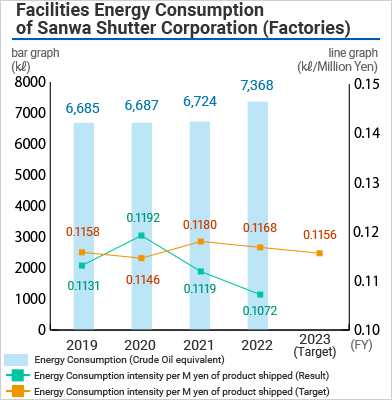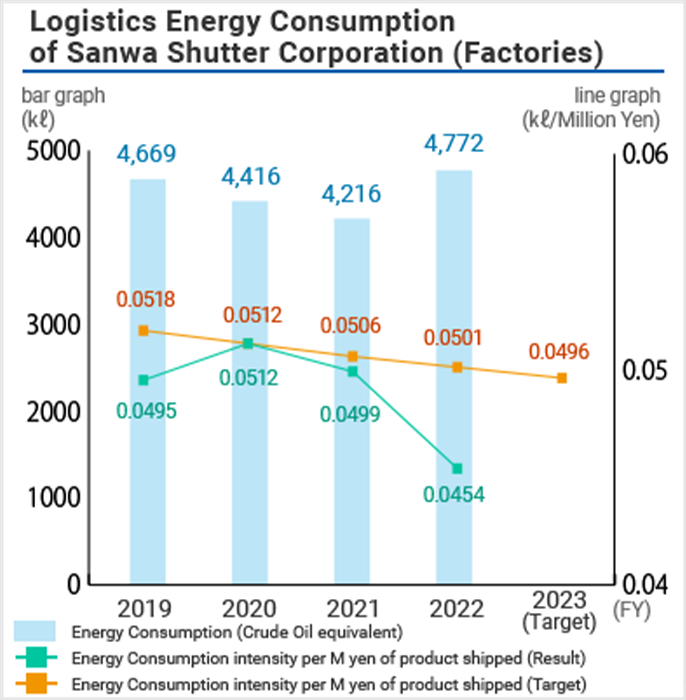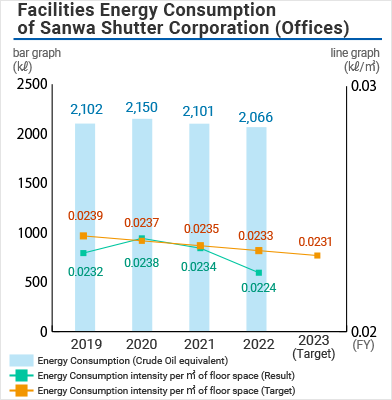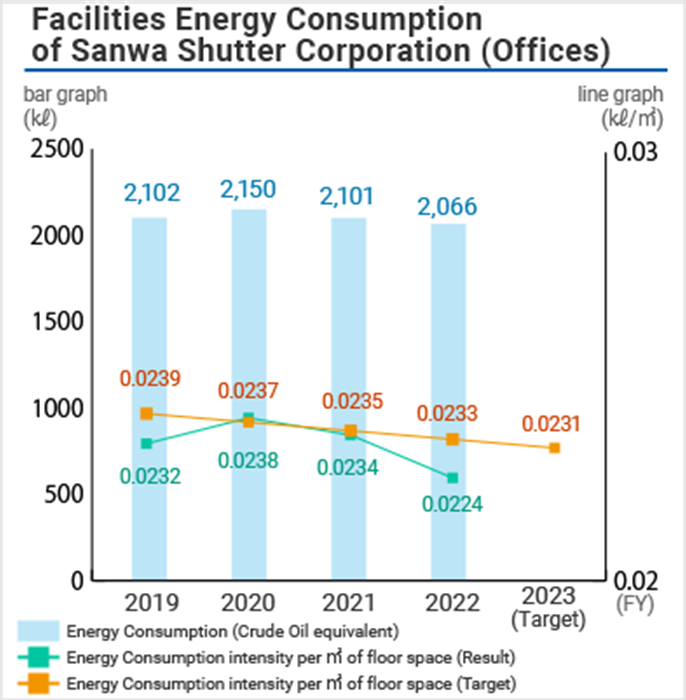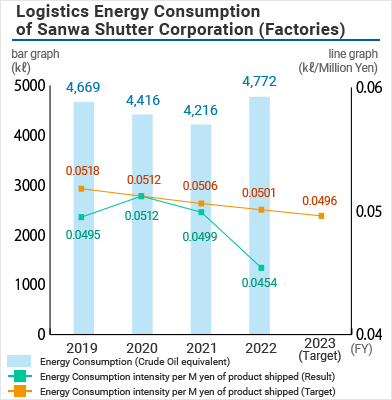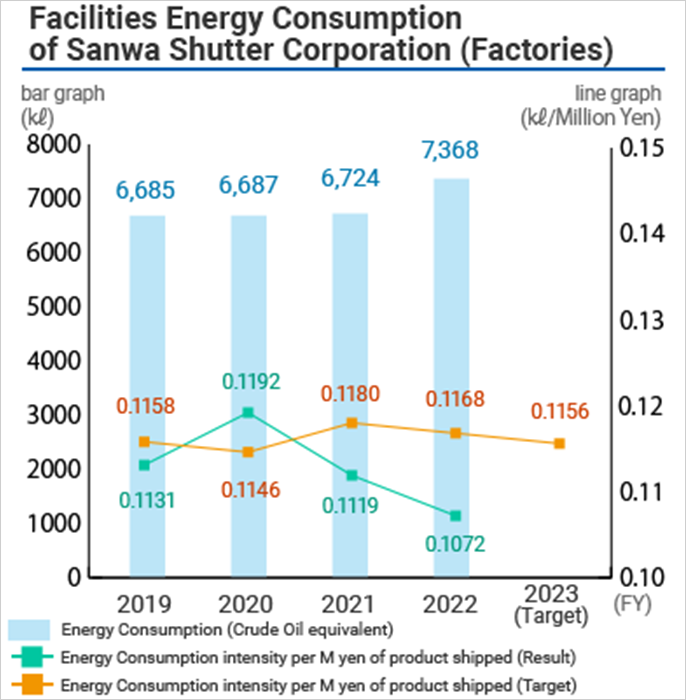Policy
The Sanwa Group contributes to the realization of a sustainable, affluent society through the emission reduction of CO2 and other greenhouse gases in order to appropriately address climate change risks.
CO2 Emission Reduction Targets and Trends
The Sanwa Group recognizes the impact of our business operations on the global environment and the importance of mitigating this impact. In May 2022 we established new environmental targets and a new policy for achieving carbon neutrality.
CO2 Emission Reduction Targets
FY2024
10% reduction from
FY2019 level
*Sanwa Shutter Corporation
FY2030
30% reduction from
FY2019 level
*Sanwa Shutter Corporation
FY2050
Sanwa Group aims to achieve
net zero CO2 emissions from business activities
CO2 Emission Reduction Trends (Japan, Global)
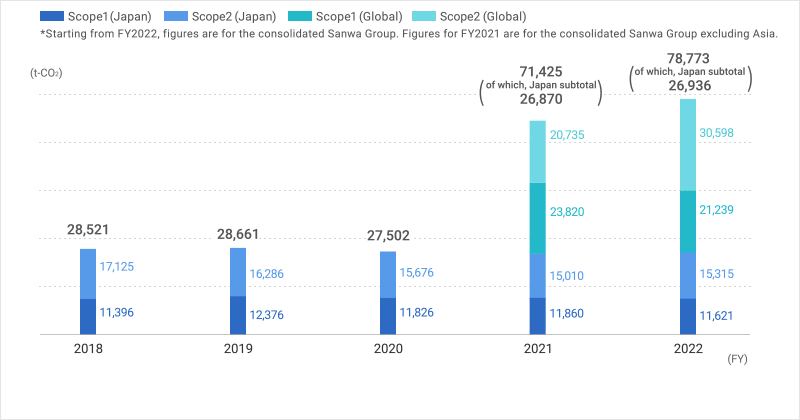
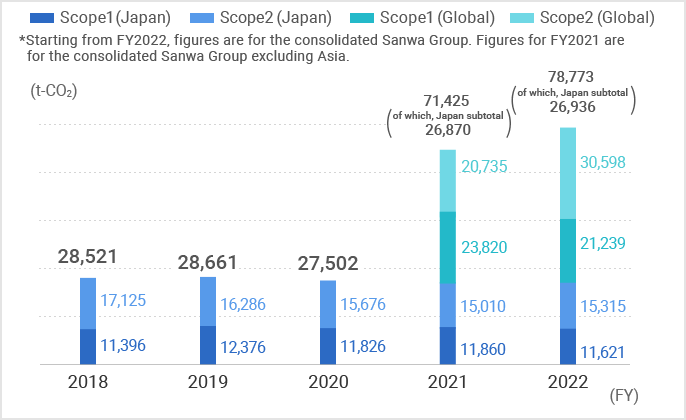
※In December 2022, Japan’s figures from FY2019 to FY2021 updated following a change in calculation method in line with a third-party verification. Adjusted emission factors have been used since FY2019.
※Due to correction in data errors, FY2022 global figures have been revised and changed (October 2023).
Before correction :(Scope1) 21,482 t-CO2 (total) 79,016 t-CO2
After correction :(Scope1) 21,239 t-CO2 (total) 78,773 t-CO2
※Due to correction in data errors, FY2021 global figures have been revised and changed (November 2023).
Before correction :(Scope1) 29,040 t-CO2 (Scope2) 19,590 t-CO2 (total) 75,500 t-CO2
After correction :(Scope1) 23,820 t-CO2 (Scope2) 20,735 t-CO2 (total) 71,425 t-CO2
Initiatives to Reduce Energy Consumption and CO2 Emission
Sanwa Shutter Corporation and other domestic group companies have established and are operating an environmental management system based on ISO 14001 guidelines, and we are working to reduce our impact on climate change by setting targets for energy reduction and efficiency, as well as targets for lower CO2 emissions.
CO2 (Scope1+2) Emission Reduction Trends (Sanwa Shutter Corporation)
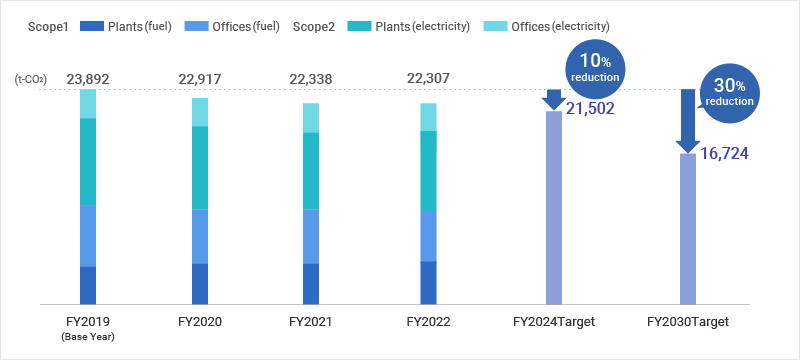
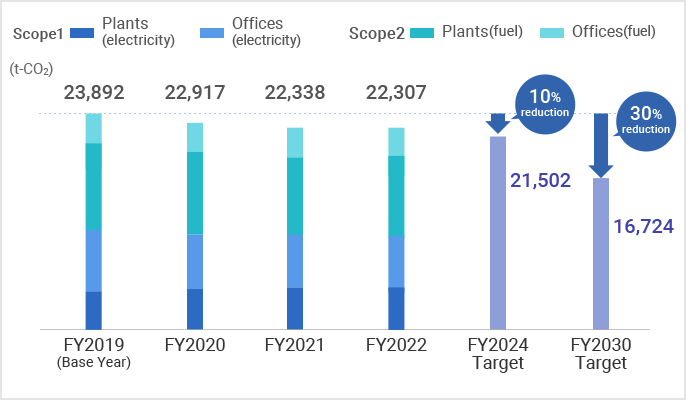
※Figures from FY2019 to FY2021 have been updated following a change in calculation method in line with a third-party verification. Adjusted emission factors have been used since FY2019.
※The Japan Management Association GHG Certification Center (JMACC) has provided third-party verification of the values for Sanwa Shutter Corporation’s CO2 emissions for FY2021 to FY2022.
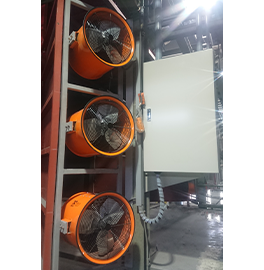
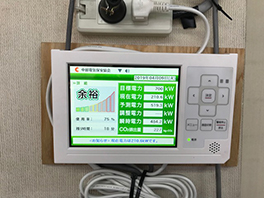
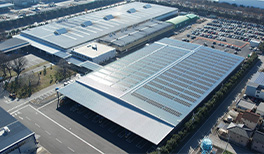
(Ota Door Plant logistics building)
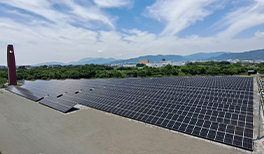
To achieve our CO2 reduction targets, Sanwa Shutter Corporation calculates and reduces Scope 1 emissions (direct emissions from business activities) and Scope 2 emissions (indirect emissions from the manufacturing stage of energy used in business activities) at production sites (plants) and nonproduction sites (offices).
At our plants, initiatives for reducing Scope 1 emissions include upgrading to energy-efficient equipment and reducing operating hours by improving productivity. Scope 2 emission reductions include using renewable energy, switching to LED lighting, as well as using monitoring systems to visualize demand and consumption of electricity to reduce energy use.
In March 2021, Sanwa Shutter's Ota Door Plant switched from using boilers for drying paint to using electric fan heaters, reducing kerosene consumption by more than half.
In December 2021, solar power generation system were installed on the roof of the logistics building at the Ota Door Plant. The total area of the panels is approximately 3,500 m2 and they reduced CO2 emissions to approximately 73 t- CO2 per year in FY 2021 and contributed to approximately 280 fewer t-CO2 of CO2 emissions in FY 2022.
In addition, in July 2023, solar power generation system was installed on the premises of the Sanwa Shutter’s Kyushu Plant. The total area of the panels is approximately 7,000 m2, almost twice the area of the Ota Door Plant’s panels, and they should reduce CO2 emissions to approximately 460 t-CO2 per year.
In our offices, in addition to switching to LED lighting and updating air conditioning systems, the Company is switching to eco-friendly sales vehicles to reduce gasoline consumption.
As a result, despite of the increase in electricity and fuel use at the plant due to increased shipments, Sanwa Shutter Corporation’s CO2 emissions (Scope 1 + 2) in FY 2022 decreased by 0.1% from the previous year and 6.6% from FY 2019 (the base year). Overall domestic CO2 emissions increased by 0.2% from the previous year.
Initiatives to Reduce Energy Consumption in Logistics (Sanwa Shutter Corporation)
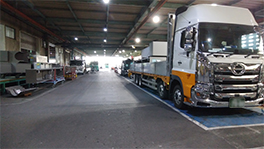
Adhering to the Law Concerning the Rational Use of Energy, Sanwa Shutter Corporation is working to achieve a 1% reduction in energy consumption intensity of production per year and a 1% average improvement in energy consumption intensity of production per year over five years. To reach these goals, the Company is implementing multiproduct mixed delivery using depots (small distribution centers) in the Tokyo metropolitan area, Sendai, and Shikoku. In addition, in July 2020, the Company introduced a vehicle dispatch and warehouse management system to improve the efficiency of vehicle dispatching and promoted better warehouse entry/exit and inventory management. These moves helped improve the loading ratio and reduced the number of vehicles sent out.
Initiatives to Reduce Energy Consumption and CO2 Emission (North America)
In FY 2021, ODC began calculating CO2 emissions (Scope 1 + 2) from ODC headquarters and all plants. The results for FY 2022 were 28,724 t-CO2 (Scope 1: 7,448 t-CO2; Scope 2: 21,277 t-CO2).
Pensacola plant of ODC uses computer-controlled lighting and an energy-efficient air-conditioning system in order to reduce unnecessary electricity use.
Other initiatives to reduce energy consumption include installing skylights at the Sales Center in Pensacola, switching all lighting to LEDs at the Williamsport Plant, and changing out exterior lighting to lower wattage lightbulbs at the Matamoros Plant in Horton.
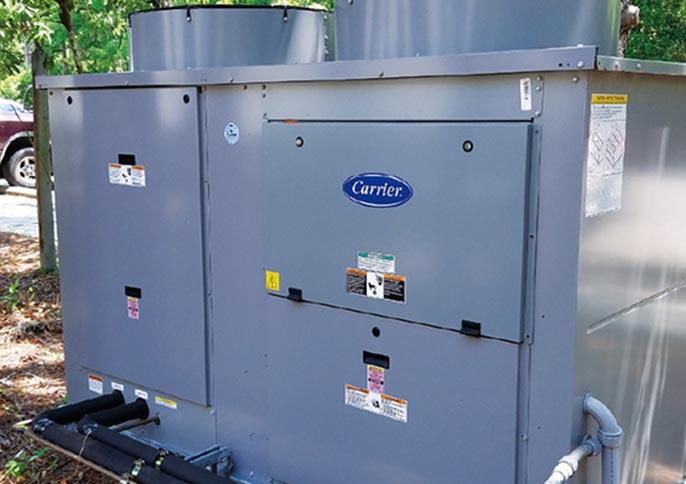
Air-conditioning system at Pensacola plant 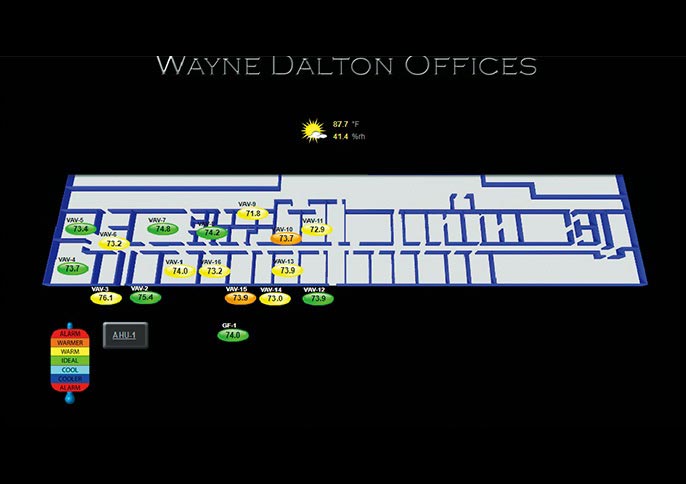
Computer-controlled energy-efficient system
Initiatives to Reduce Energy Consumption and CO2 Emission (Europe)
In FY 2021, NF Group began calculating CO2 emissions (Scope 1 + 2) from NF GmbH headquarters and all plants. The results for FY 2022 were 20,595 t-CO2 (Scope 1: 13,354 t-CO2; Scope 2: 7,241 t-CO2).
In the NF Group, Riexinger plant in Germany, NF Door plant in Poland, Robust AB's plant in Sweden, and Vertriebs sales company in Germany have acquired ISO 14001 certification and are working to reduce energy consumption. Switching to LED lighting and introducing motion sensors and light/darkness sensors contributes to reducing the amount of electricity used and electricity fees. To help reduce CO2 emissions, solar power generation systems (panels) were installed in the Luton Plant in the UK and the Schievano Plant in Italy in April 2023 as well as the Alsal Plant in Spain in May 2023.
-
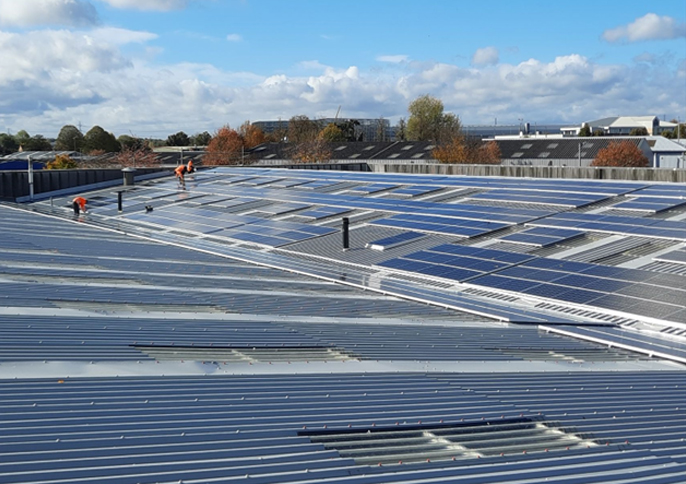
Solar power generation system
(Luton Plant) -
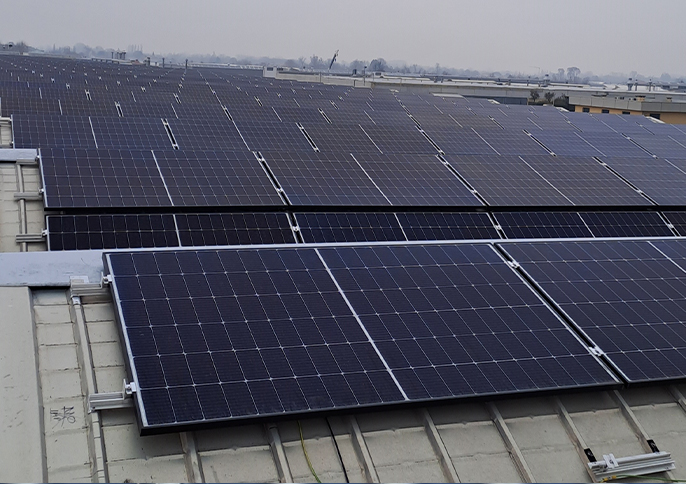
Solar power generation system
(Schievano Plant)
Initiatives to Reduce Energy Consumption and CO2 Emission (Asia)
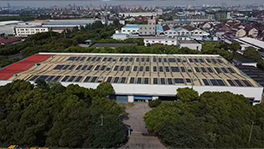
(Shanghai Baosteel-Sanwa Door)
In FY 2022, Asian subsidiaries began calculating CO2 emissions (Scope 1 + 2) from Asian subsidiaries headquarters and all plants. The results for FY 2022 were 2,517 t-CO2 (Scope 1: 438 t-CO2; Scope 2: 2,080 t-CO2).
※Due to correction in data errors, FY2022 Asian figures have been revised and changed (October 2023).
Before correction :(Scope1) 680 t-CO2 (total) 2,760 t-CO2
After correction :(Scope1) 438 t-CO2 (total) 2,517 t-CO2
In June 2023, the solar power generation system in Shanghai Baosteel-Sanwa Door became operational, further helping to reduce CO2 emissions and electricity costs.
Scope 3 Initiatives
To achieve a carbon neutral society, it is necessary to reduce CO2 emissions not only within the Company but also throughout the entire supply chain. For the first step to reduce overall CO2 emissions in the supply chain, we began calculating Scope 3 emissions in fiscal 2023. First, we calculated emissions for Category 1 (Purchased goods and services) at Sanwa Shutter Corporation due to the heavy use of metal materials, such as steel as a raw material. This calculation was based on the purchased weights of primary materials, specifically iron, aluminum, and stainless steel. We also calculated emissions for Category 3 (Fuel and energy related activities not included in Scopes 1 or 2) and a portion of Category 4 (Upstream transportation and distribution). Further, CO2 emissions for Categories 1 and 3 have been verified by a third party, the Japan Management Association GHG Certification Center (JMACC), to improve the reliability of environmental performance data.
Scope 3 Emission Calculation Results and Calculation Method
Fiscal year:FY2022(From 1/April/2022 to 31/March/2023)
Boundary:Sanwa Shutter Corporation
| CO2 Emission (t-CO2) |
Calculation Method | Third- Party Verification |
||||
|---|---|---|---|---|---|---|
| Activity volume | Emission intensity ※ | |||||
| Scope3 | 303,511 | ― | ― | |||
| Category 1 | Purchased goods and services | 286,045 | Purchased weight of steel, stainless steel, and aluminum | Emission intensity per purchased weight | 〇 | |
| Category 3 | Fuel and energy related activities not included in Scope 1 or Scope 2 | 4,807 | Energy consumption for fuel and electricity | Emission intensity per energy volume | 〇 | |
| Category 4 | Upstream transportation and distribution | 12,659 | Fuel consumption (diesel) related to the transportation of goods (factories to sales offices) which Sanwa Shutter was identified as the consigner | Emission intensity per weight of diesel | ||
※Uses emission coefficients indicated in“Database of emissions unit values for Greenhouse Gas Emissions Throughout the Supply Chain(ver.3.3)”and “National Institute of Advanced Industrial Science and Technology IDEA Ver.2.3”.
Scopes 1, 2, 3 Emissions and Composition
In fiscal 2022, the total emissions for Scopes 1, 2, and 3 (Categories 1, 3, and 4) came to 325,819 t-CO2. Specifically, Scope 1 emissions were 10,316 t-CO2 (3.2% of the total) and Scope 2 emissions were 11,992 t-CO2 (3.7% of the total). The majority of emissions came from Scope 3, with Categories 1, 3, and 4 combined reaching 303,511 t-CO2, or 93.2% of the overall emissions. Notably, the emission volume for Scope 3 Category 1, which came to 286,045 t-CO2, made up a significant portion: 87.8% of the total (94.2% within the Scope 3 composition percentage). Starting next fiscal year, we will systematically broaden our calculation categories. Our initial focus will be on Category 11 (use of sold products), a category closely related to us as a manufacturing company. This category covers the CO2 emissions resulting from customers’ use of the products we that we sold.
Fiscal year:FY2022(From 1/April/2022 to 31/March/2023)
Boundary:Sanwa Shutter Corporation
| CO2 Emission (t-CO2) |
Breakdown | Third- Party Verification |
||||
|---|---|---|---|---|---|---|
| Percentage of total | Percentage within Scope 3 | |||||
| Scope1 | 10,316 | 3.2 | ― | 〇 | ||
| Scope2 | 11,992 | 3.7 | ― | 〇 | ||
| Scope3 | 303,511 | 93.2 | 100.0 | |||
| Category 1 | Purchased goods and services | 286,045 | 87.8 | 94.2 | 〇 | |
| Category 3 | Fuel and energy related activities not included in Scope 1 or Scope 2 | 4,807 | 1.5 | 1.6 | 〇 | |
| Category 4 | Upstream transportation and distribution | 12,659 | 3.9 | 4.2 | ||
| total | 325,819 | 100.0 | ― | |||
※Figures might not add up to 100% due to rounding.
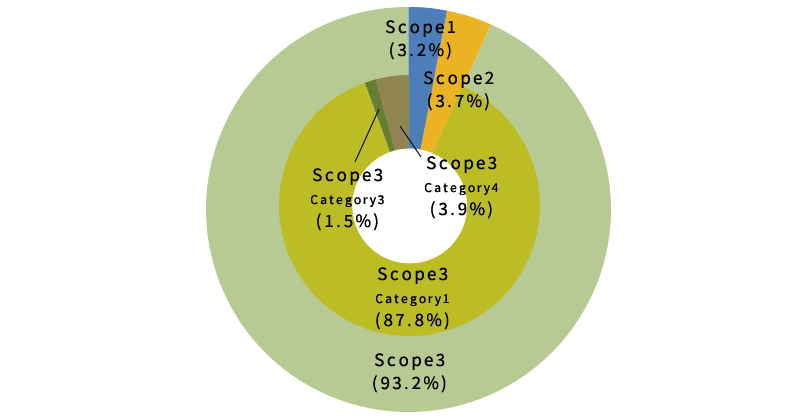
Collaboration with external organizations
As a member of Keidanren (Japan Business Federation), the Sanwa Group exchanges information related to climate change. Moreover, the Representative Director Chairman of Sanwa Shutter Corporation, our Group company, has served as Chairman of the Japan Rolling Shutters & Doors Association (JSDA), and has been working hard on flood prevention. The goal is to create a resilient society that can withstand intensifying natural disasters due to climate change. We have also been actively involved in the management of this association, including the appointment of the Representative Director and Chairman of Sanwa Shutter Corporation as its chairman.
Sanwa Shutter Corporation complies with Japan’s Law Concerning the Rational Use of Energy, a law that addresses climate change in Japan. As well, we submit reports to the government once a year on energy consumption, our achievement of energy conservation targets, and greenhouse gas emission volumes.
